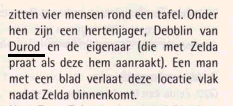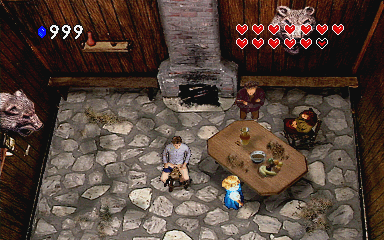Zelda's Adventure - An Ode To Durod
What do you think is the most obscure location in a Zelda game? You might think it's a small area tucked away in the giant maps of Breath of the Wild and Tears of the Kingdom, or a cut location like fstdan from Ocarina of Time. But those are either tied to very popular games and/or events like the Gigaleak. We need to get deeper. You might think of locations in games like Ripened Tingle's Balloon Trip of Love or the Game & Watch Zelda titles, but those games have pretty good coverage from Zelda-related sites and wikis nowadays.
The Animation Magic Zelda games (surprise, surprise) have two unvisited locations on their world map that are properly named in early concept art - Koridai's Gingko Pinnacle and Gamelon's lighthouse. But they're still visible on the world map and certain spots in-game. Zelda's Adventure has several locations that are only named in unused voicelines and the official Dutch guide, but you actually visit them in-game. They're not that obscure.
But what about a location in Zelda's Adventure that's never visited in-game and is only mentioned once in the full, almost-unpublished version of this Dutch guide?

Let's talk about Durod.
Sections:
The Dutch Guide -- Debblin of Durod -- An Ongoing Mystery
The Dutch Guide
I believe it's best to start off with the source of Durod in question - the Dutch guide.
Philips ran a phone hotline related to their CD-i console, in which gamers could call in and ask for tips. As part of the hotline, Philips had official guides written up for many CD-i games. This includes all three Zelda titles, and I have archived all of them in their respective games' sections. (It appears that Hotel Mario was never given an official guide, or at least never had it published. Understandable, given its different and more "arcade-y" gameplay style.) These official Zelda guides appear to be based off development materials, as the names it gives to characters and enemies matches those used in concept art and cut voice-lines.

To give a couple of examples; both the Zelda's Adventure guide and its unused voicelines correctly name Alice (the sitting woman near Great Wimbich) and Kron the Peddler (the merchant near Ubato Hills). Furthermore, the guides for the Animation Magic Zelda titles namedrop Kulvan (the blacksmith from TFoE) and Grimbo (the power glove guy from TWoG), years before concept art featuring those names was shown. Therefore, it's safe to assume that any name used in the guides is the character's (or enemy's) intended name.
Philips would give these guides to CD-i-focused publications, such as the British magazine CD-i or the Dutch magazine CD-interactief, and they would appear in the publications' tips & tricks sections as either small snippets or in their entirety. The thing about Zelda's Adventure is that it was released in 1996, late in the CD-i's lifespan. The aforementioned British magazine would stop soon after its release, leaving CD-interactief as the only CD-i publication left running. Therefore, it essentially got exclusive rights to publish the game's guide.
Chunks from the guide would be used for the tips & tricks section of CD-interactief until 1998, when the magazine would undergo a format change that reduced it to a section in the Oog & Oor magazine. Despite the greatly lowered page count, the magazine would post full guides in its tips section - spread across multiple issues - until it ceased publication in 1999. The guide for Zelda's Adventure was one of the last two full guides that the magazine published.
Debblin of Durod
This is where Durod comes in. In the section dealing with getting to the Shrine of Illusion, the White Steed Lodge's interior is described as such:
N11a: Binnen in de White Steed Lodge zitten vier mensen rond een tafel. Onder hen zijn een hertenjager, Debblin van Durod en de eigenaar (die met Zelda praat als deze hem aanraakt). Een man met een blad verlaat deze locatie vlak nadat Zelda binennkomt.

Essentially, there are four people around this table, but the guide names a couple; the Lodge's owner, Debblin van Durod, and a "deerhunter" that might just be Debblin's occupation. Among this group of four is a tray-carrying waiter who leaves soon after Zelda enters, and who I believe is the owner. His single voiceline is about making Bumbleberry Tea and notifying Zelda that the Lodge is full, which lines up well with him being the guy who runs the place. This leaves the three people at the table. The guy clad in brown has dialogue, but he ends up reusing the voiceline used by the owner.

This is a bit odd as there are voicelines in the game data meant for one of the Lodge's patrons (and NOT the owner). The speaker is annoyed by all the (non-existent) noise in the establishment, but immediately changes his tone when he sees Zelda and offers her some Bumbleberry Tea. In addition to this, the player can speak to every other named character in the guide. Which means...

This guy is (most likely) Debblin van Durod!
As for whether or not he's the deerhunter character, that's up for you to decide.
And, at long last, we can focus on Durod itself. In Dutch, the word "van" is a tussenvoegsel; essentially, it's a prefix before a person's surname that indicates what place their family comes from. The two most famous examples of this convention, Vincent Van Gogh and Ludwig Van Beethoven, have surnames that suggest their families came from Goch (Gogh) and a place called Beethoven (likely Bettincourt/Bettenhoven), respectively. It appears that this guy's original English name, Debblin of Durod, was translated into what its Dutch equivalent would be... which isn't a unique case.

Bitterbeck, a guy who lives near the Shrine of Air entrance, is called Bitterbeck de Bergman (Bitterbeck the Mountain Man) in the guide. It's likely he was called that (or something similar) in the original development materials, and it helps prove that the guide was willing to use Dutch words in character names.
So we have Debblin, a person and potential deerhunter who hails from Durod. Cool!
Anything else?
An Ongoing Mystery
Well, um... that's literally all we know about Debblin and/or Durod. No other NPC mentions the land of Durod, not even in unused dialogue. Debblin himself is more concerned about noisy Lodge patrons and being left alone than talking about his life or (presumed) deer-hunting exploits. And, as far as we know, no other place in Tolemac is called Durod, not even in the guide or in the known development assets. Debblin and the land he hails from are almost complete mysteries, even within the absolutely anomalous series entry that is Zelda’s Adventure.
Maybe we’ll find out some answers if more Zelda’s Adventure pre-release stuff gets released. But until then... 
Return to top
Last updated: January 8th, 2025.